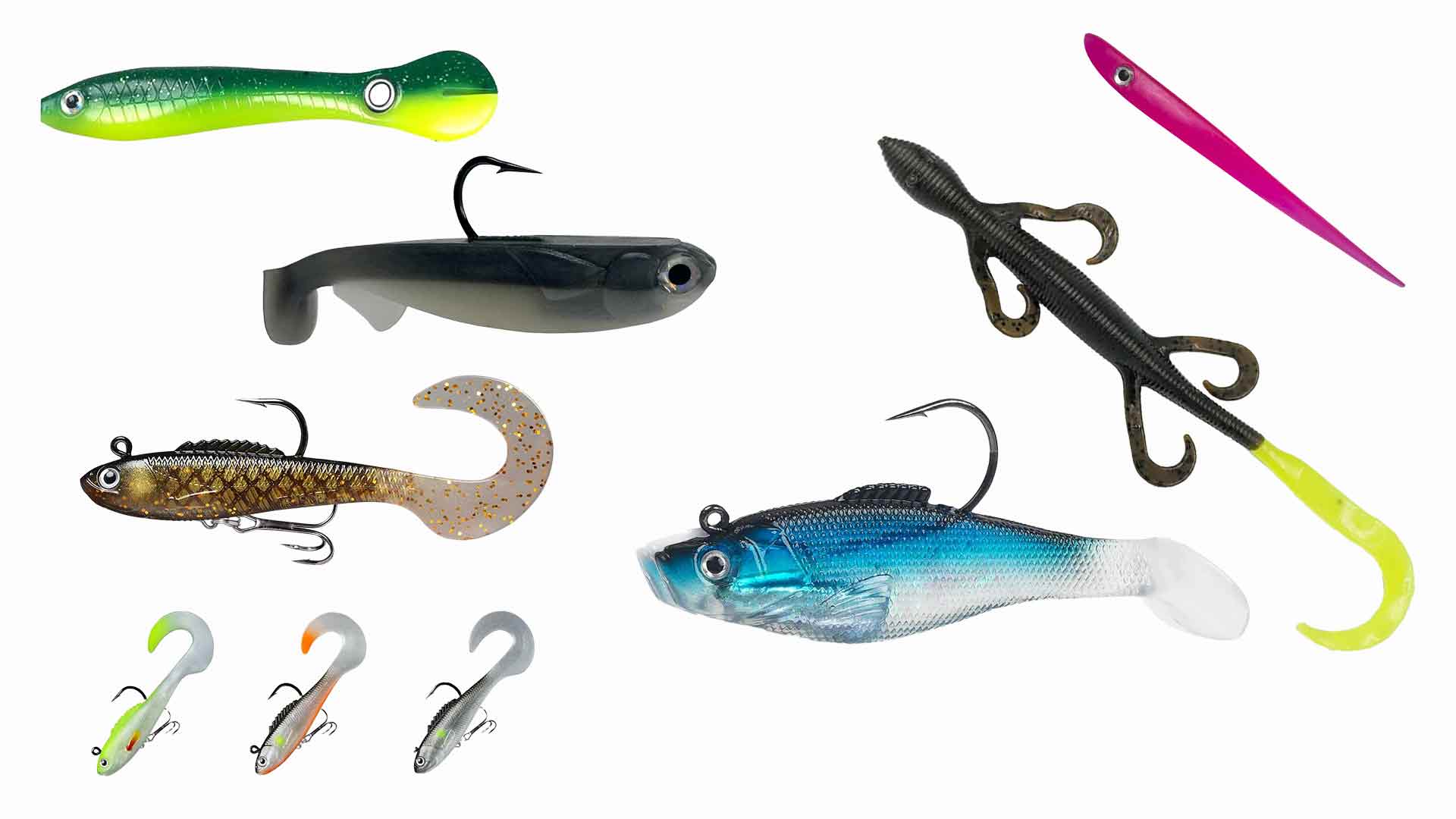Soft plastics are a cornerstone in the world of fishing, renowned for their versatility and lifelike action. These lures, made from flexible materials like PVC and silicone, are crafted to imitate a variety of natural prey, including worms, baitfish, and crustaceans. This comprehensive guide explores the different types of soft plastics, their optimal uses, and advanced techniques to enhance your fishing experience. Whether you’re a beginner or a seasoned angler, mastering the use of soft plastics can significantly improve your success on the water.
The Design and Functionality of Soft Plastics
Soft plastics are designed to mimic the appearance and movement of various aquatic creatures. The pliable nature of these lures allows them to move realistically in the water, replicating the subtle movements of live bait. This realistic action, combined with the ability to infuse scents and flavors, makes soft plastics highly appealing to predatory fish. Research has shown that the flexibility and texture of soft plastics can trigger predatory instincts, even in fish that are not actively feeding.
Using scents and flavors in soft plastics can also play a crucial role in attracting fish. Scents can mask human odors and other unnatural smells, while flavors encourage fish to hold onto the lure longer, increasing the chances of a successful hookset. These features make soft plastics a powerful tool for anglers looking to increase their catch rates.
Exploring the Varieties of Soft Plastics
Soft plastics come in a wide array of shapes and designs, each tailored to specific fishing situations and target species:
Worms: Soft plastic worms are a staple in bass fishing, known for their versatility and effectiveness. These lures come in various lengths, colors, and tail designs, including straight tails, curly tails, and ribbon tails. The flexibility of these worms allows for multiple rigging options, such as the Texas rig, Carolina rig, and wacky rig. Angler Rick Clunn emphasizes the subtle presentation of straight-tail worms in clear water, where a natural, lifelike action can entice wary bass.
Creature Baits: Designed to resemble crawfish, lizards, and other aquatic creatures, creature baits are particularly effective in dense cover. The multiple appendages and unique shapes of these lures create significant movement and vibration, attracting predatory fish in various environments. Larry Nixon, a pro angler and lure designer, recommends creature baits during post-spawn periods when bass are aggressive and guarding their nests.
Grubs: Featuring a small, rounded body and a curly tail, grubs are versatile lures that can be used to catch a variety of species, including bass, panfish, and trout. The tail’s fluttering action creates vibrations that attract fish, making grubs an excellent choice for cold water fishing. These lures can be rigged on jig heads or used as trailers on spinnerbaits and chatterbaits to enhance their action.
Flukes: Also known as jerkbaits, flukes are designed to mimic baitfish with their streamlined bodies and forked tails. These lures are effective in both fresh and saltwater, providing a darting action that can trigger strikes from species like bass and redfish. Kevin VanDam highlights the effectiveness of flukes during the shad spawn when bass are actively feeding on baitfish near the surface.
Tubes: Tubes have a cylindrical body with tentacle-like appendages at one end, mimicking the appearance and movement of crayfish and gobies. These lures are particularly effective in rocky or sandy environments where these prey items are common. Joe Balog, a seasoned angler and guide, suggests using darker-colored tubes in clear water to imitate gobies, a favorite food of smallmouth bass.
Optimal Use of Soft Plastics
Understanding the optimal times and techniques for using soft plastics can greatly enhance your fishing success:
- Seasonal Dynamics: Soft plastics are effective year-round, but their utility can change with the seasons. In spring, when fish are actively feeding and spawning, soft plastic worms and creature baits are ideal for targeting fish in shallow waters. During the summer, as fish move to deeper, cooler waters, grubs and tubes become valuable tools for reaching these depths. In the fall, flukes are perfect for mimicking baitfish during the shad migration when predatory fish are aggressively feeding.
- Water Clarity: The choice of soft plastic color and type is influenced by water clarity. In clear water, natural and translucent colors like green pumpkin and watermelon are effective, as they closely resemble the local forage. In contrast, bright or dark colors, such as chartreuse and black, are more visible in murky water and can attract fish through both sight and contrast.
Cover and Structure: Soft plastics excel in fishing around structures like submerged vegetation, rocks, and docks. These environments provide shelter for prey, making them hotspots for predatory fish. Techniques like pitching and flipping with creature baits or worms can effectively target fish hiding in dense cover. For open water or sparse cover, drop shotting with finesse worms or flukes can be an excellent choice, allowing the lure to hover just above the bottom, mimicking a vulnerable prey item.
Advanced Techniques for Soft Plastics
Mastering advanced techniques can help anglers fully exploit the potential of soft plastics:
- Texas Rigging: A staple technique, Texas rigging involves threading the soft plastic onto a hook and embedding the hook point into the lure to make it weedless. This rig is ideal for fishing in heavy cover, as it allows the lure to navigate through vegetation without snagging. The Texas rig can be used with various soft plastics, including worms, creature baits, and tubes.
- Carolina Rigging: This technique uses a heavy sinker, a leader, and a soft plastic lure to fish in open water or over flats. The sinker stays on the bottom while the soft plastic floats above, mimicking a feeding baitfish or crawfish. This presentation is particularly effective for targeting bottom-holding fish and can be used with a range of soft plastics.
- Drop Shotting: A finesse technique, drop shotting involves tying the hook above a weight, allowing the soft plastic to hover just above the bottom. This setup is ideal for targeting suspended fish or those that are finicky. The subtle action of the soft plastic can entice bites from fish that are otherwise difficult to catch.
- Wacky Rigging: In this method, a soft plastic worm is hooked through the middle, allowing both ends to wiggle freely. The wacky rig is particularly effective in clear water or around sparse cover, as the erratic movement can provoke reaction strikes. This technique is often used with finesse worms or stick baits.
Selecting the Right Soft Plastics
Choosing the appropriate soft plastic involves several considerations:
- Size: The size of the soft plastic should match the local prey and the target species. Larger soft plastics are typically used for bigger fish, while smaller lures can appeal to a broader range of species. The size also affects the action of the lure, with larger baits producing more substantial movement and smaller baits offering a subtler presentation.
- Color: The color of the soft plastic is crucial for its effectiveness. In clear water, natural colors like green pumpkin and shad work well, while bright or dark colors like chartreuse and black are better suited for murky water. The choice of color should also consider the light conditions and time of day.
- Scent and Flavor: Many soft plastics are infused with scents and flavors to enhance their attractiveness. Scented lures can be particularly useful in murky water or heavily fished areas, where fish are more cautious. The added scent can mask unnatural odors and encourage fish to hold onto the lure longer, increasing the chances of a successful hookset.
Maintaining Your Soft Plastics
To ensure longevity and effectiveness, proper maintenance of soft plastics is essential. After each fishing trip, inspect the lures for damage, such as tears or missing appendages. Store soft plastics in a cool, dry place, away from direct sunlight, which can cause the material to degrade. Using dedicated tackle boxes with dividers can help prevent the lures from becoming tangled or damaged.
Conclusion: The Impact of Soft Plastics in Fishing
Soft plastics are a versatile and effective tool in any angler’s toolkit. Their ability to mimic a wide range of prey and adapt to various fishing conditions makes them indispensable for targeting species like bass, trout, and panfish. By understanding the different types of soft plastics, when and where to use them, and the advanced techniques that can enhance their effectiveness, anglers can greatly improve their success on the water. At BaitBeast, we offer a diverse selection of premium soft plastics to meet the needs of every angler. Equip yourself with the right knowledge and gear, and take your fishing experience to the next level with BaitBeast’s top-quality soft plastics.


 baitbeast.com
baitbeast.com
Leave a Reply
Want to join the discussion?Feel free to contribute!